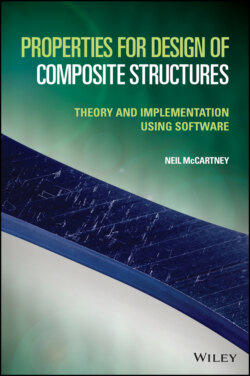Читать книгу Properties for Design of Composite Structures - Neil McCartney - Страница 32
2.15 Introducing Contracted Notation
ОглавлениеThe general formulation for describing the elastic constants of anisotropic materials involves fourth-order tensors that are difficult to apply in many practical situations where analytical methods can be used. A simplified contracted notation is usually used for such analyses where the fourth-order tensors of elastic constants are replaced by a second-order matrix formulation that is now described. The matrix formulation makes use of the fact that the stress and strain tensors are symmetric. These symmetry properties enabled the derivation of the relationships (2.149)–(2.151).
The components of the stress and strain components are now assembled in column vectors of length six so that
(2.162)
It should be noted that a factor of two has been applied only to the shear terms of the relation involving the strains so that the quantities 2εij for i≠j correspond to the widely used engineering shear strain values. General linear elastic stress-strain relations, including thermal expansion terms, have the contracted matrix form
(2.163)
where CIJ are symmetric elastic constants, which are components of the second-order matrix C, and where UI are thermoelastic constants associated with the tensor βij, which are components of the vector U, the uppercase indices I and J ranging from 1 to 6. For orthotropic materials the stress-strain relations have the simpler matrix form
(2.164)
The stress-strain relations (2.163) may be written, using a repeated summation convention for uppercase indices over the range 1, 2, …, 6, as
(2.165)
The inverse of the matrix CIJ is denoted by the symmetric matrix SIJ such that
(2.166)
where δIK is the Kronecker delta symbol having the value 1 when I=J and the value 0 otherwise. On multiplying (2.165) on the left by SLI and on using (2.166), it can be shown that
(2.167)
The quantities VI are the components of the vector V which is associated with the thermal expansion tensor αij. The matrix form of (2.167) is given by
(2.168)
and the corresponding orthotropic form is
(2.169)
When expanded using the stress and strain tensor components and the symmetry of SIJ, the stress-strain relations may be written as
(2.170)
